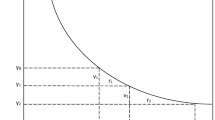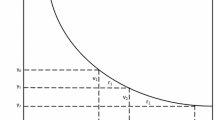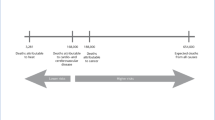Abstract
A contingent valuation survey was conducted in Shizuoka, Japan, to estimate the willingness to pay (WTP) for reductions in the risk of dying and calculate the value of statistical life (VSL) for use in environmental policy in Japan. Special attention was devoted to the effects of age and health characteristics on WTP. We find that the VSLs are somewhat lower (103 to 344 million yen) than those found in a virtually identical survey applied in some developed countries. These values were subject to a variety of validity tests, which they generally passed. We find that the WTP for those over age 70 is lower than that for younger adults, but that this effect is eliminated in multiple regressions. Rather, when accounting for other covariates, we find that WTP generally increases with age throughout the ages in our sample (age 40 and over). The effect of health status on WTP is mixed, with WTP of those with cancer being lower than that of healthy respondents, while the WTP of those with heart disease is greater. The VSLs for future risk changes are lower than those for contemporaneous risk reductions. The implicit discount rates of 5.8%–8.0% are relatively larger than the discount rate regularly used in environmental policy analyses. This survey is the first of its kind in Japan, and provides information that is directly useful for estimating the benefits of environmental and other policies that lower mortality risks to the general population and subgroups with a variety of specific traits.
Similar content being viewed by others
References
Alberini A, Cropper M, Krupnick A, Simon N (2004a) Does the value of statistical life vary with age and health status? Evidence from the US and Canada. Journal of Environmental Economics and Management 48:769–792
Alberini A, Cropper M, Krupnick A, Simon N (2004b) Willingness to pay for mortality risk reductions: does latency matter? National Center for Environmental Economics, USEPA Working Paper #2004-01
Aldy JE, Viscusi WK (2004) Age variations in workers’ value of statistical life. Working Paper 10199, December 2003, NBER Working Paper Series
Arrow K, Solow R, Portney PR, Learner EE, Radner R, Schuman H (1993) Report of the NOAA panel on contingent valuation. Federal Register 58:4601–4614
European Commission (1999) Extern-E: externalities of energy, vol 7. Methodology 1998 update. Office for Official Publications of the European Communities, Brussels, pp. 1–518
Freeman AM (2003) The measurement of environmental and resource values. Resources for the Future, Washington DC
Hamermesh D (1985) Expectations, life expectancy, and economic behavior. Quarterly Journal of Economics 100:389–408
Hammitt JK, Graham JD (1999) Willingness to pay for health protection: inadequate sensitivity to probability? Journal of Risk and Uncertainty 8:33–62
Hurd M, McGarry K (1996) The predictive validity of the subjective probabilities of survival in the health and retirement survey. Economics Department, SUNY (State University of New York), Stony Brook
Itaoka K, Saito A, Krupnick A, Adamowicz W, Taniguchi T (2006) The effect of risk characteristics on the willingness to pay for mortality risk reductions from electric power generation. Environmental and Resource Economics 33:371–398
Johannesson M, Johansson P-O (1996) To be, or not to be, that is the question: an empirical study of the WTP for an increased life expectancy at an advanced age. Journal of Risk and Uncertainty 13:163–174
Johannesson M, Johansson PO, Löfgren KG (1997) On the value of changes in life expectancy: blips versus parametric changes. Journal of Risk and Uncertainty 15:221–239
Jones-Lee MW, Hammerton M, Phillips PR (1985) The value of safety: results of a national sample survey. Economic Journal 95:49–72
Kageyama A (2004) Characteristics of Shizuoka Prefecture in a viewpoint of test marketing (in Japanese). SRI 78:39–55, Shizuoka Research Institute, Shizuoka
Krewski D, Burnett RT, Goldberg MS, Hoover K, Siemiatycki J, Abrahamowicz M, White WH (2000) Reanalysis of the Harvard six cities study and the American Cancer Society study of particulate air pollution and mortality, part I: replication and validation. Health Effects Institute, Cambridge, MA, pp. 39–128
Krosnick JA, Holbrook AL, Berent MK, Carson RT, Hanemann WM, Mitchell RC, Presser S, Kopp RJ, Ruud PA, Smith VK, Moody WR, Green MC, Conaway M (2002) The impact of “no opinion” response options on data quality: non-attitude reduction or an invitation to satisfice? Public Opinion Quarterly 66(3):371–403
Krupnick A, Alberini A (2000) Cost of illness and WTP estimates of the benefits of improved air quality in Taiwan. Land Economics 76(1):37–53
Krupnick A, Alberini A, Cropper M, Simon N, Itaoka K, Akai M (1999) Mortality risk valuation for environmental policy. Discussion Paper 99-47. Resources for the Future, Washington DC
Krupnick A, Alberini A, Cropper M, Simon N, O’Brien B, Goeree R, Heintzelman M (2002) Age, health and the willingness to pay for mortality risk reductions: a contingent valuation study of Ontario residents. Journal of Risk and Uncertainty 24:161–186
Krupnick A, Bhattacharya S, Alberini A, Veronesi M (2006) Mortality risk valuation in six countries: testing benefit-transfer approaches. Proceedings of the Third World Congress of Environmental and Resource Economics, Kyoto, Japan, July 3–7, 2006
Ministry of Health Labor and Welfare of Japan (2000) National Nutrition Survey 1999
Nakanishi J (1995) Theory of environmental risk (in Japanese). Iwanami Shoten, Tokyo
Organisation for Economic Co-operation and Development (2003) Programme for international student assessment. http://www.oecd.org/document/0/0,2340,en_32252351_32236173_33694144_l_l_l_l,00.html. Cited 22 August 2006
Persson U, Norider A, Hjalte K, Gralen K (2001) The value of a statistical life in transport: findings from a new contingent valuation study in Sweden. Journal of Risk and Uncertainty 23:121–134
Pope CA, Thun MJ, Namboodiri MM, Dockery DD, Evans JS, Speizer FE, Health CW Jr (1995) Particulate air pollution as a predictor of mortality in a prospective study of US adults. American Journal of Respiratory Critical Care Medicine 151:669–674
Royal Society of Canada (2001) Report of an expert panel to review the socio-economic models and related components supporting the development of Canada-wide standards for particulate matter and ozone. Royal Society of Canada, Ottawa, Ontario
Slovic P (1987) Perception of risk. Science 236:280–285
Smith VK, Desvousges WH (1987) An empirical analysis of the economic value of risk changes. Journal of Political Economy 95:89–113
Smith VK, Evans MF, Kim H, Taylor DH (2004) “Do the ‘near’ elderly value mortality risks differently?” Review of Economics and Statistics forthcoming
Tsuge T, Kishimoto A, Takeuchi K (2005) A choice experiment approach to the valuation of mortality. Journal of Risk and Uncertainty 31:73–95
US Environmental Protection Agency (USEPA) (1999) The benefits and costs of the clean air act, 1990–2010. Report to the US Congress. US Environmental Protection Agency, Washington DC
US Environmental Protection Agency (2004) Benefits of the proposed inter-state air quality rule. US Environmental Protection Agency, Washington DC
Ware JE, Jr., Kosinski M, Keller S (1997) SF-36 physical and mental health summary scales: a users manual. Quality Metric, Lincoln, RI
Yamamoto S, Oka T (1994) The value of a statistical life of Japanese people: an estimate from a survey on the willingness to pay for reducing a health risk of drinking water (in Japanese). Environmental Science 7:289–301
Author information
Authors and Affiliations
About this article
Cite this article
Itaoka, K., Krupnick, A., Akai, M. et al. Age, health, and the willingness to pay for mortality risk reductions: a contingent valuation survey of Shizuoka, Japan, residents. Environ Econ Policy Stud 8, 211–237 (2007). https://doi.org/10.1007/BF03353958
Received:
Accepted:
Published:
Issue Date:
DOI: https://doi.org/10.1007/BF03353958




